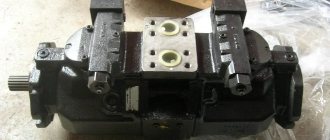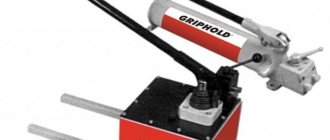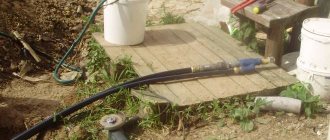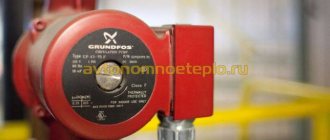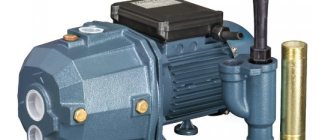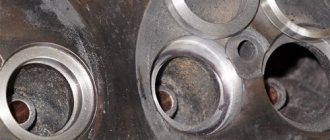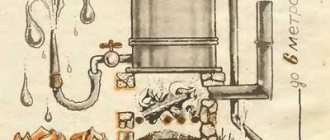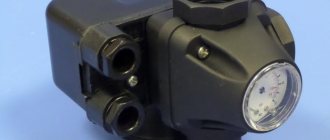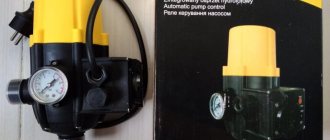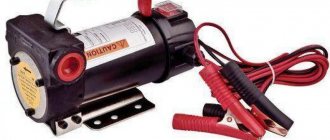SHARE ON SOCIAL NETWORKS
FacebookTwitterOkGoogle+PinterestVk
A water pump is a hydraulic device that sucks, pumps and moves liquid from one point to another. This occurs on the principle of transfer of kinetic or potential energy to the environment. Water units are presented in several varieties and differ in design, power, performance, efficiency, pressure and pressure.
Pumps for pumping water differ in power, design and performance
Pump for pumping water: characteristics of the unit
A water pump is a hydraulic unit that extracts, pumps and moves liquid horizontally or vertically. This occurs through the transformation of electrical energy into potential or kinetic energy. The internal structure of the unit depends on the method of energy conversion.
Pump performance is the volume of water that it can pump per unit of time.
Any autonomous or conventional electric water pump, regardless of the type of device, consists of a metal body, an impeller located on the shaft, seals, bearings, a guide device, an electric motor, a casing on it, suction and pressure pipes. The unit body is made of cast iron or steel. It has two holes. The bottom one is used for water intake, where the suction pipeline is connected through the inlet pipe, and the side one, where the pressure hose is fixed, is used for injection.
The main operating parameters of a mechanical water pump include power, pressure, and productivity. The first indicator directly determines the effective performance of the unit and indicates the amount of kW/h that the device will consume. The developed pressure determines the permissible distance over which liquid can be pumped. Here attention is paid to the length of the pressure pipeline.
The depth of liquid rise indicates from what level water can rise. The performance of the device determines the volume of water that the unit can pump per unit of time.
To come in
Already registered? Sign in here.
There are currently 0 users on the page
There are no users viewing this page.
Attention Bearing Buyers
Attention Bearing Buyers
Dear customers, send your questions and requests for the purchase of bearings and components by mail or call now: +7 Delivery of bearings in the Russian Federation and abroad. Bearing catalog on the website
Attention Bearing Buyers
Dear customers, send your questions and requests for the purchase of bearings and components by mail or call now: +7 Delivery of bearings in the Russian Federation and abroad. Bearing catalog on the website
Types of water pumps according to location and quality of pumped liquid
Depending on their location, pumps for pumping liquids can be surface or submersible. The first type is installed at a certain distance from the source, with which it communicates using a hose or pipeline. The power of the unit is determined by the value of this distance. The larger it is, the more powerful the unit is needed. Submersible models are mounted directly into a hydraulic structure. The body of the device must be completely or partially immersed in water.
Pumps for pumping water at location can be surface or submersible
Depending on the design of the working element, which affects the water flow, pumps can be divided into vane and vibration pumps.
Taking into account the degree of contamination of the pumped liquid, water supply pumps can be classified into three types. The first class is suitable for clean water, where the content of solid impurities does not exceed 150 g/m³. This category includes surface, borehole and well units.
The second type is capable of pumping medium-contaminated liquid with a solid particle content of no more than 200 g/m³. This group includes circulation, self-priming and fountain pumps. To pump highly dirty water containing more than 200 g/m³ of impurities, drainage and surface sewerage units are used.
Important! The correct choice of a pumping unit according to the criterion of liquid purity is the key to avoiding rapid wear of mechanical parts and equipment failure.
The housing of submersible pump models must be partially or completely placed in water
Design features of a household pump
Hydraulic builders offer owners of country houses to draw up simple technical specifications. It takes into account the location and nature of the water source, the expected level of consumption, the distance over which the liquid needs to be transported, and so on. The fewer errors there are, the easier it is to choose a pump for transfer.
The simplest type of hydraulic equipment in technical terms is called console.
Household pumps may differ in design depending on the manufacturer.
Its feature is a one-way supply of liquid to the plane of the impeller. There are console pumps of the KM and K types. If there is a well on the site, then in this case you should choose the variety of the same name. The technical description for the product indicates from what depth the unit will raise life-giving moisture.
In addition to these two types of equipment, there are several more:
- Circulating - belong to the low-power type. Used in everyday life to supply hot water.
- CNS – multi-stage sectional models. They have proven themselves well in heat supply systems. Withstands significant temperature changes.
- Drainage - refers to submersible types. Used for pumping liquids containing impurities and suspensions.
- “Irtysh” - used for working with clean or slightly dirty water.
- ANS – characterized by the ability to independently absorb liquid. Widely used in drainage canals. Such a transfer pump is equipped with an electric motor or an internal combustion engine.
The horizontal type of hydraulic equipment is advisable when a high-load water supply system is installed. When choosing pumping equipment, you need to remember the need to ensure its uninterrupted operation. If you are not sure that a source of electricity will always be at hand, then it is better to opt for an internal combustion engine. A similar decision is made when it comes to seasonal use of the unit.
Power supply options for water pumping equipment
The pumping unit can be powered by electricity or liquid fuel. The first type of device uses alternating current to operate the engine, as a result of which it is completely dependent on the electrical network. Therefore, an electric water pump is selected if it is present. It is very important to take into account the network voltage, since a specific unit model is designed for a certain number of phases.
Liquid fuel pumps are equipped with an internal combustion engine. Such units are characterized by smaller dimensions, mobility and ease of operation, repair and maintenance.
There are two types of liquid fuel pumping units - gasoline and diesel. Gasoline pumps use a gasoline-oil mixture as fuel, which is prepared in a certain ratio of components. Such units are much quieter and have a lower cost. However, they consume quite a lot of fuel, as a result of which they are not very economical. Diesel units use diesel fuel as fuel. The pumps operate with a high noise level, but are characterized by high efficiency.
Important! Pumps for pumping 220 V water are more expensive than liquid fuel units.
Water pumps can be powered by electricity or liquid fuel
What is a 12 Volt water pump?
A special category of pumping equipment includes small 12 volt water pumps. They can be used for watering a vegetable garden, garden, pumping liquid from sources into reservoirs, for draining and flushing a well or well, washing a car, filling and draining artificial reservoirs, aquariums of various sizes.
The 12 volt water pump is no different from its large-sized counterpart. It consists of a housing, impeller and shaft made of stainless steel, a wet-type rotor, bronze elements of the hydraulic system, connecting fittings, and a mechanical cleaning filter, which protects the device from the ingress of large solid particles of debris larger than 0.5 mm.
The 12 volt pump is characterized by compact dimensions, ease of operation, energy independence, since the unit can operate not only from the mains, but also from a battery, resistance of the housing and structural elements to water ingress, absence of noise and vibration during work, and low cost.
Helpful advice! For home use, you can make such a pump for pumping water with your own hands.
12 Volt water pumps are characterized by compact size, energy independence and ease of operation
The productivity of the mini-pump is 15-25 l/min. The unit provides a liquid pressure of 20-40 mm of water. Art. The low-voltage pump can be operated at liquid temperatures from 10 to 80 degrees.
Varieties of Low Voltage Small Water Pumps
Low-voltage pumps can be divided into several types: circulation pumps, vacuum pumps, diaphragm pumps and pump pumps. The last group includes submersible, surface and hand pumps for pumping water. They are used for pumping liquid from basements, cellars, cleaning wells and wells, and removing contaminated liquid from cesspools.
12 Volt water pumps can be used for autonomous water supply systems. Manual units are activated through certain physical efforts that a person must apply.
12 Volt vacuum pumps are used for pumping water from above-ground reservoirs and underground sources. They are characterized by high performance, low noise and vibration levels, low energy consumption, and the ability to operate in a wide temperature range.
Low voltage small water pumps are divided into circulation pumps, diaphragm pumps, vacuum pumps and water pumps.
Diaphragm pumps are used to take water from a well, pump it from one container to another, drain artificial reservoirs and wash equipment. The operating principle of such units is based on changing the total volume of working fluid. The membrane, used as the main working element, draws in water and pushes it out through the inlet pipes.
Characteristics of 12 Volt circulation water pumps
12 Volt circulation pumps are centrifugal-type units that are used in heating and hot water supply systems. The main task of such devices is to maintain the required pressure when the main pump fails or in the absence of a power supply network.
Circulation pumps are available in two varieties - with a dry or wet rotor. In the latter type of unit, the rotor is located in the liquid. The contacts are hidden in a special stainless steel compartment. This pump has small dimensions, is characterized by long-term uninterrupted operation, low noise level and ease of use. The main disadvantage is the low efficiency, which can be as low as 50%.
Mini water pumps with a dry rotor, in which the rotor is separated by ceramic or metal sealing rings, are characterized by higher efficiency. It can only pump clean water, otherwise the tightness of the mating rings may be broken. Such pumps are available in horizontal, vertical and block types.
12 Volt circulation water pumps are centrifugal-type devices that are used in the installation of hot water supply and heating systems
A special category is made up of high-pressure equipment that operates on 12 volts. It can be safely used to supply water to the heating system.
Your own gas station: how to pump gasoline correctly
Pumping fuel is not the most pressing task for the average car owner, but sometimes you still have to face it... Particularly confused owners of diesel cars do not refuel them directly at the gas station, but transport the fuel in cans to the garage, where they pump it into 200-liter barrels to settle from water and dirt and repeated filtering (yes, this is not a joke, there are enthusiasts!) Someone purposefully buys “left” gasoline from hand and stores it for storage. Some people really have to keep fuel in “mini-tanks” (usually in the form of the same 200-liter barrels) - for example, at a hunting lodge or base. One way or another, the issue of pumping fuel may well be relevant, and a funnel is not always enough for this. Let's explore the most popular devices for this exciting activity.
Semi-professional mini gas stations
For a personal garage, such equipment is clearly redundant and expensive, but if you need to organize a fuel point on a pond for boats and boats or a “micro-refueling station” at a forest camp, then this option will be the best. The semi-professional fuel dispensing pump is designed for a typical 200-liter barrel and has a capacity similar to that of a regular gas station that we use every day - tens of liters per minute. Which is not surprising with a 300-400 watt motor.
There are options that operate from an AC outlet, and others from a 12/24 volt battery; the latter can be powered directly from the on-board network of the equipment being refueled. The cost, however, is high - from 4,000 rubles for Chinese nameless options and from 15-20 thousand for branded ones. However, manual gear barrel pumps of the “meat grinder” type cost from one and a half thousand rubles and can be a godsend for someone who is waiting for the apocalypse, sitting in a cache on several hidden barrels of fuel!
Battery-powered electric fuel pump
Miniature autonomous pumps for gasoline and diesel fuel are made by the Japanese and cloning professionals by the Chinese. The main feature is that it is powered by finger batteries! Using two AA batteries, the pump is capable of pumping up to a ton of fuel at a speed of 10-12 liters per minute. Some models have an auto-shut-off function, like “adult” gas stations - that is, you can insert the pump hose into the container and not worry that the gasoline will overflow as soon as you turn your back for a second!
Many people criticize the Chinese clones, but the Japanese ones fully correspond to their claims. The downside is the limited power, which does not allow you to extend the short standard hose if necessary. Therefore, if you need to refuel from a large barrel, you will have to drive close to it or drag it to the gas tank flap. Well, and secondly, the pump’s love for expensive and powerful alkaline batteries (although there are also versions with an AC adapter). Cost - from 1,800 rubles for the Japanese original and from 500 for the Chinese analogue.
Electric fuel pump for injection car
Although the tank of most cars contains a bulky fuel module with a plastic cup, filters and a gasoline level sensor, a very compact “cartridge” is usually hidden inside it - an electric fuel pump. And it can be successfully used for pumping fuel outside the car. This solution makes sense if you had to replace the old pump with a new one, but not because of its complete failure, but because of a decrease in pressure, which, by the way, happens much more often.
In our case, a low fuel pump is not a hindrance - in case of abnormal use of the pump in the mode of pumping gasoline from container to container without the need to create a nominal pressure in the fuel rail, even a worn pump will produce quite sufficient performance. To make a “rocker” out of a pump, you need to put a piece of gas-resistant hose (preferably transparent, PVC) on its fitting and extend the wires of the block, then connecting them either to the car battery or to the charger.
Regarding the longevity of the pump: the standard performance of most electric pumps ranges from 70-80 to 150-200 liters per hour, and they work for years. When using an older pump to pump fuel from time to time, its life is extended almost to infinity, even with short-term “dry” operation, when the container is empty, and with a piece of rag as a coarse filter at the inlet.
Regarding performance: the pump of a one and a half liter injection machine pumps approximately 70-80 liters per hour, a motor with a volume of two liters and above pumps 130-150 liters per hour. It turns out that he will pump a 20-liter canister into the tank in a quarter of an hour? But 15 minutes for a canister is a very long time... In fact, it’s not like that! The pump's rated performance is normalized in normal mode, when it has to pump pressure into the fuel rail. In the case of pumping from container to container, gasoline gurgles freely and unhindered. Our simple experiment demonstrated a flow rate of five liters per minute. Therefore, it will take only four minutes to pump 20 liters of fuel.
The main advantage of using an old but working fuel pump, which you still have after replacing it with a new one, is that the system will be virtually free. The main disadvantage is the diameter of the pump “cartridge”. I have come across the thinnest one - 38 mm, and it will not fit into every metal canister, although it usually fits into barrels and polyethylene canisters without problems. In this case, it makes sense to look for a remote (main) fuel pump, located not in the tank, but under the bottom of the car. These were used on injection UAZs, Volgas, Gazelles, many “Americans”, old “Europeans” (models of the 80-90s from Opel, Peugeot, etc.) This pump has fittings for the hose both at the inlet and outlet, and the hose will fit into any container. The cost of a used pump from Volga is about 500 rubles.
Manual fuel pump
As a super economical option, there are also hand pumps. “Pear” is a classic of the genre, familiar to our great-grandfathers who were motorists. Its modern version (pictured on the right) is not much different technically from the traditional one. If you use it to transfer from a container located above to a container located below, then a couple of “pumps” will fill the line, and then gravity will do everything, and you will not have to spit out gasoline. If you need to pump “up” or simply between containers that are on the same level, then you will have to do a fair amount of hand work...
It’s unlikely that anyone has measured the performance of this type of pump, but we’ll check anyway! Surprisingly, the “pear” was not far behind the electric pump: it pumped five liters in 1 minute, and a manual one in 1.5 minutes! However, the devil is in the volume: after five liters the desire to squeeze a pear disappears, and the electric one hums and pours as if nothing had happened...
So the “pear” should not be written off; it is quite suitable for refueling mopeds, lawn mowers and other small equipment. And it costs about 100 rubles. By the way, car owners of older diesel cars place the classic version of the “pear” in the gap in the fuel line in front of the pump - to manually pump the system after airing. And sometimes such bulb pumps are also installed on new cars (for example, on a diesel Renault Duster), and the manufacturer installs it as standard and offers to pump diesel fuel into the system after replacing the fuel filter.
Types of water pumps according to operating principle
Vane units act on the pumped liquid through a special wheel. There are blades on it that are directed in the opposite direction relative to the movement of water. As a result of the transfer of torque to the wheel shaft from the engine shaft, centrifugal force arises between the blades. Liquid from the functional chamber begins to be forced out, entering the pressure pipe under high pressure.
The vane pump can be a single- or multi-stage unit. The first option is equipped with one rotation wheel, and the second - several.
Depending on the impeller configuration, vane units can be centrifugal, vortex or self-priming.
Vane pump design: 1 – guide vane; 2 – shoulder blades; 3 – impeller; 4 – interscapular channels
The vibration pump for pumping water from a container of any size and type is equipped with a functional reservoir separated by a plate membrane. On one side there is a cavity filled with liquid, and on the other there is a vibrator that sets the thin membrane in motion. The membrane alternately bends in different directions, changing the functional volume of the cavity and the internal pressure in it.
As the pressure decreases, a vacuum occurs, which causes the intake valve to open. At this time, water from the suction pipe moves freely into the cavity of the unit. When the membrane bending position changes to the opposite direction, the pressure increases, intensely pushing water out through the valve.
Important! Vibrating pumps, in comparison with vane versions, are capable of raising liquid to a greater height.
In terms of efficiency, vibration pumps are inferior to vane units. They fail faster. In addition, they are characterized by a high degree of vibration. However, they have a lower cost, and repairing the unit will not require large expenses.
Vibrating submersible pumps are capable of lifting water to great heights
Alternative equipment options
The drainage type is used to transport liquid from a container located on the surface or depth. Due to this, submersible and drainage types are often confused. The instructions indicate the maximum permissible level of contamination of water and technical fluid that the unit can handle.
Low-power drainage gadgets are equipped with a wear-resistant body.
Its power plays an important role. The more impurities in the liquid, the stronger the machine must suck.
When buying a pump for pumping water, you should find out the warranty period
In addition, a small drainage pump for supplying water must have the following characteristics:
- Resistance to aggressive environments;
- Impact resistance;
- Quick installation;
- Ability to adjust the pressure power;
- Supports universal power supplies.
A variety of pumps for pumping water are used in industry and private households to create an autonomous water supply system. Power and efficiency differ depending on the model. A detailed analysis of your own needs will help you choose the right one. How often do you plan to use the unit, how much water is needed, is there a constant source of electricity on the site - the answers to these questions will allow you to manage your money rationally.
Characteristics of surface water pumps
A surface dimensional or mini pump is designed to draw liquid from a source that is located at some distance from the device. Such units can also be used for pumping water from pits and basements when performing construction or repair work. They are often used for watering a summer cottage, for an irrigation system, or for increasing pressure in a centralized water supply network.
The surface unit can be located in the basement, which should be dry and warm, in a separate extension or in a caisson near the well head. Its bottom should be located 0.5 m below the soil freezing level.
Related article:
Fountain pump: the heart of an artificial water source
Operating principle and purpose of the device. Types of units. Criterias of choice. Manufacturers. Installation. DIY pump.
Surface pumps are capable of lifting water to a height of 7-8 m, which depends on the design of the unit. They are characterized by high power and performance. Surface pumps are small in size, making them easy to operate. They are distinguished by their mobility and low cost. Surface equipment can pump water from a shallow source. It is more durable due to the fact that the metal structure does not come into contact with water.
A mini-pump for pumping 220 Volt water can be supplemented with automation, which will allow it to work in autonomous mode. In order for the unit to be able to lift water from a considerable depth, the pump is equipped with a remote ejector.
The surface pump for pumping water must be located at some distance from the source
Disadvantages include the formation of a high noise level during operation, a small immersion depth and high sensitivity to pumping contaminated liquid, which will lead to rapid wear of the internal mechanism of the unit.
Important! Some models of surface pumps require filling the line with water to start operating the unit.
Characteristics of vortex and centrifugal pumps for pumping water
Based on the method of transporting liquid, surface pumps are divided into vortex and centrifugal pumps. In the first type of unit, the impeller blades have a special shape. They have a rectilinear configuration, due to which the liquid rotates between them in a characteristic manner, which allows for a powerful vortex flow directed into one channel.
This is ensured by the fact that each blade section gives the water additional acceleration. As a result, such a pump produces high pressure, which is 5 times higher than this parameter of a centrifugal pump.
Due to their simple design, vortex pumps are easy to operate and maintain.
Vortex pumps are compact in size and low cost. Due to the simplicity of the design, the unit is easy to operate, repair and maintain. The immersion depth of the suction hose is 8 m. However, such small pumps are characterized by low efficiency and pump only clean water.
Important! A vortex surface pump can operate in two directions, including in reverse mode.
Vortex pumps are equipped with a closed or open impeller. In the first case, the blades are made in the form of cells, which are closed at the ends with blades. The design of the open impeller has no restrictions.
Centrifugal pumps have an impeller structure in which the blades help disperse water over all the walls of the inner chamber. The increase in pressure is achieved due to centrifugal force. The pumps are afraid of air getting inside, so they are additionally equipped with an ejector, which pumps air out of the pump before starting and during operation.
Due to low wear of internal mechanisms, the centrifugal pump has a long service life
Such units are characterized by large dimensions, low noise operation, and high efficiency. The immersion depth of the suction hose is 10-13 m. The internal mechanism is less subject to wear than that of vortex units, due to which the centrifugal pump has a longer service life.
A powerful water pump provides stable pressure and pressure in the network, and it is possible to adjust these parameters. The cost of the equipment is much higher than the price of vortex analogues. Therefore, it is advisable to use them when arranging an autonomous water supply system. Surface pumps can be self-priming or fountain type.
Self-priming and fountain surface pumps
Self-priming pumping units are characterized by compactness, simplicity of design, ease of operation and low maintenance. The equipment is used for watering gardens, providing water supply to a private home, and lifting water from clean surface sources.
Such pumps can be ejector or non-ejector. The first option involves raising water by pumping a vacuum into the ejector, which ensures high pressure. The ejector is installed on the suction hose and lowered into the water. During suction, part of the liquid is returned to the ejector, which increases the inlet pressure. The big disadvantage of this design is that the efficiency decreases as the ejector deepens, and energy consumption increases.
Self-priming pumps are compact, simple in design and easy to operate.
Helpful advice! You can also use such an electric ejector pump to pump water from a barrel and drain pools.
The ejectorless device sucks in liquid due to the specific design of the hydraulic equipment. Such pumps are capable of raising water to a height of no more than 9 m.
To increase pressure in a centralized water supply or heating network, there is a special type of surface equipment called a circulation pump. It is installed directly on the pipeline of the water supply system or mounted in front of the boiler when installing a heating network. A circulation pump is also used for watering land.
Another type of surface pumping equipment is a fountain unit. It is widely used in landscape design. Such units are installed when arranging decorative ponds, fountains, mini-ponds, streams, and cascading waterfalls. Pumping equipment can also be used to irrigate individual areas that are located close to each other.
Some models of fountain pumps are equipped with a liquid filtration function, this allows you to pump sea water
To service large-scale objects and create massive water compositions, there is a high-power water compressor. For small reservoirs and fountain ensembles, low-power units are installed.
Important! Among fountain-type pumps, there are models equipped with a liquid filtration function, thanks to which they can pump sea water.
For such pumps, special shaped nozzles are produced that contribute to the formation of beautiful fountain jets. Fountain units can be installed at the bottom of a reservoir or mounted outside the source.
Low-power devices for pumping water
A water pump for domestic needs has small dimensions - up to 30x20 cm. The maximum depth from which hydraulic equipment raises life-giving moisture is 200 m. The first thing you need to pay attention to when purchasing is the type of product. There are two of them: well (vibration type), used at a depth of up to 15 m, and borehole (centrifugal type) - its maximum depth does not exceed 200 m.
In most cases, the choice is made in favor of the vibration model.
Its main advantages are its small size and high efficiency. They are connected to a 220 V network and are immediately ready for use. They can be used both for pumping liquid from a barrel and into a well. Hydraulic builders remind you that the vibration type should not be taken as the ultimate truth.
Small pumps for pumping water are quite cheap
Centrifugal pumps have their advantages:
- It can be used as surface or submersible;
- Stronger water pressure is created by rotating the impeller;
- Unpretentious in maintenance;
- Easy to install.
A miniature vibration pump is an almost universal solution. Economical consumption of electricity with high efficiency ensured its popularity. At the same time, for seasonal and minor use, you need to choose a centrifugal system.
Features of submersible pumps for pumping water
Submersible pumps 12 Volt or 220 V are installed directly into the source for collecting liquid. In this case, the engine can be submerged in water or located above its surface. This type of pumping equipment is capable of pumping out liquid from a considerable depth. The unit has high performance and is characterized by effective engine cooling.
Deep pumps for wells and drainage and fecal devices
Submersible pumps, based on the purpose of the unit, are divided into the following groups: drainage, well, borehole and fecal.
Well pumps are used to pump water from wells and mines. They are distinguished by their significant dimensions, shallow immersion depth, high power, and silent operation without vibration. The units can work with liquids that contain sand, silt or clay.
Borehole pumps are characterized by compact dimensions, elongated shape, and are installed directly in the well. Water can be taken from very great depths. Such units are characterized by high power and productivity. They can be used for clean or slightly contaminated water.
Drainage units are used to collect lightly contaminated or dirty water containing sand, clay, grass and small debris from basements, pits, trenches.
Fecal pumps can work with liquid containing large solid particles with a diameter of up to 35 mm
Important! There are submersible drainage models equipped with knives for grinding impurities.
Fecal pumps for pumping wastewater are similar to drainage pumps. Such units can work with heavily polluted waters that contain large solid particles with a diameter of about 35 mm. Some designs feature a powerful stainless steel or cast iron cutting mechanism to shred larger debris. Such pumps are used to pump waste and fecal water into a special septic tank.
Important! Sewage pumps come in both submersible and surface types.
The fecal pump for pumping dirty water is characterized by resistance to aggressive environments. The device is additionally equipped with special floats, which, if it is necessary to stop the operation of the device, give signals.
Drainage pumps are used to remove dirty water containing clay, sand, grass and small debris.
Characteristic features of aquarium pumps
An aquarium pump, also known as a compressor, aerator or pump, is designed to circulate water in a tank in order to saturate it with oxygen for the normal functioning of its inhabitants. Aeration is performed around the clock, ensuring a stable air exchange regime. Such pumps are used to mix the upper and lower layers of water in order to equalize the temperature of the liquid, thereby preventing its changes. The operation of the device helps to destroy the oily, unpleasant film that interferes with normal gas exchange.
The operation of an aquarium pump for pumping water is as follows. There is a motor inside the compressor. It takes oxygen from the room and forces it into a tube, pumping it to the sprayer, which is located in the aquarium.
The pump can operate on mains power or independently on batteries. There are one- and two-channel models. The latter option is characterized by durability, small size, low noise and high performance.
Based on their design components, aquarium pump pumps come in vibration and diaphragm types. The first type is characterized by high power and durability. The equipment operates quite noisily, creating vibrations. It is recommended to install a piston unit for aquariums with a capacity of more than 200 liters.
An aquarium pump is used to circulate water in a tank to saturate it with oxygen.
The diaphragm pump makes virtually no noise and has low power consumption. However, such a unit is characterized by poor performance, so it is advisable to use it for aquariums with a capacity of up to 150 liters.
Depending on the installation option, there are surface and submersible 12 Volt water pumps for an aquarium. The first type is attached using special suction cups or clamps under water to the bottom of the aquarium. The surface version is installed outside the fish tank. Only air tubes are supplied to it.
Important! A surface aquarium pump is used for small tanks when keeping particularly demanding fish.
Selection criteria and recommendations
Hydraulic equipment is characterized by 2 main indicators. The first is the volume of water supplied. The Q constant is measured in cubic meters. If we are talking about a volumetric type of unit, then in this case the indicator is measured in l/sec. The higher the planned level of consumption, the higher Q should be. The second indicator is the pressure force (N), measured in meters of water column. The indicator reflects the difference in the cross-section of water before and after pumping equipment.
An analysis of your own needs will help you decide on the choice of unit. Only in this case the likelihood of problems and increased costs at the stage of practical operation is reduced to zero.
You should not buy a pump that is too powerful for pumping water if it will be used for simple tasks.
When choosing a pumping station, it is necessary to determine:
- Engine power sufficient to operate within the required operating characteristics;
- The minimum required number of protective chambers designed to protect individual structural elements from water ingress;
- The minimum required number of seals installed at the ends of the tank and pipes.
The consumer's task is to determine the planned operating range of the equipment. A graph is used for this. The minimum and maximum H are recorded along the 0-Y axis, and the minimum and maximum Q are recorded along the 0-X axis. After this, a curve is drawn on the graph displaying the minimum and maximum efficiency values. That part of the graph that is within the efficiency limits is called the operating range.
